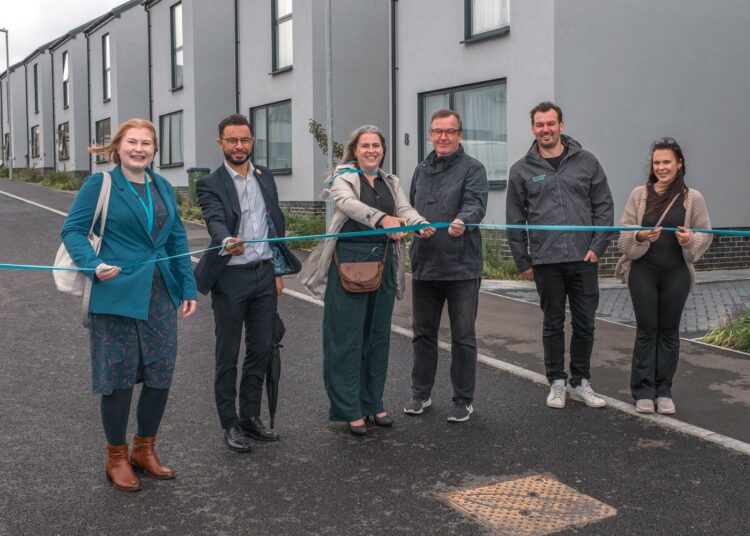The first tenants have moved into a £10 million modular housing scheme in Peacehaven which was built on the site of the J Webb Plant Hire business.
The completion of the scheme’s 40 “affordable” homes was marked by a ribbon-cutting ceremony at the site, in Cripps Avenue.
The project is the fruit of a partnership involving the leading social housing provider Stonewater and Newhaven modular construction company Boutique Modern, with support from consultants Baily Garner and Lewes District Council.
It provides 40 energy-efficient modular homes for affordable rent, built just three miles from the Cripps Avenue site.
Members of the design and construction team joined Stonewater to mark the completion of the scheme which the housing association said had brought significant benefits to the local economy.
These included more than £3.5 million spent with local businesses, suppliers and sub-contractors within the district and the creation of 14 full-time construction jobs.
The site consists of nine one and two-bedroom flats and 31 two and three-bedroom houses. Each home has built-in energy-efficiency measures to help tenants keep their fuel bills down.
One of the first tenants, Angela De Gray-Birch said: “I couldn’t say a bad thing about this flat or the development. I think it’s beautiful and so do my friends that visit.
“Everyone I’ve spoken to at Stonewater has been lovely and I’ve already noticed my electricity bills are lower too. I’m incredibly happy living here.”
The site also includes a sculpture commissioned by Stonewater and created by Rich Dean, who works from his studio in Newhaven.
The sculpture, Ascension of the Fallen, contains 1,000 stainless steel poppies and remembers those involved in the First World War when Peacehaven was named and some of the first homes were built.
Stonewater development manager Naomi Mooney said: “We’re incredibly proud of this development and the opportunity it has given us to provide a high number of wonderful homes for customers while reducing the impact on the environment of constructing much-needed new affordable homes.
“It’s wonderful to see the site complete, with our poppy sculpture providing a lovely focal point, and to know that not only are customers benefiting from warm high-quality homes but they are already seeing a reduction in energy bills too.”
Boutique Modern managing director Dick Shone said: “It’s been fantastic to collaborate with Stonewater on this project, a company which has similar ambitions to us regarding sustainability and social value.
“There are so many reasons why we need to embrace modular construction. It’s a greener choice, generating less waste and boasting a smaller carbon footprint than traditional methods.
“And Cripps Avenue is a great example of how low-impact modular housing can make an architectural statement as well as improving communities and people’s lives, without hurting the planet.”
Stonewater manages about 33,600 homes across England for more than 75,000 people. It provides affordable properties for general rent, shared ownership and sale.
It also provides specialist accommodation such as retirement and supported living schemes for older and vulnerable people, domestic abuse refuges, a dedicated LGBTQ+ safe space and young people’s foyers.
In 2021, Stonewater took over the provision of the women’s refuge in Brighton, previously provided by a specialist local charity RISE, prompting an outcry in the community.










Let’s hope that’s the case and there properly maintained unlike the horror stories we read about and I wish the tenants the best for there futures.
What a shame they’re not up for ‘affordable sale’ instead of ‘affordable rent’.
It’s a bit 50/50 these days. Still, one of the benefits of modular is a bit like IKEA. Easy to make more modules.
“Affordable” housing is a nonsense, just like right-to-buy. Why should some people get a subsidy, paid for by the rest of us, when they buy their house? Who “deserves” this free money?
Instead, let’s build more houses where they’re needed so prices come down for all.
Right to buy was a good idea ruined by implementation. If every sale went towards building a new council home, it would have been great. No idea where the money actually went.
The right to buy has never been at open market value though, so there never was going to be enough from the sale of one home to build / buy another. It was a flawed scheme from the start, forced through by central government onto local councils, without top up payments to the councils to make up for the shortfall between the sale price and the cost of new homes.
If a council wanted to take all the money from right to buy fro the say past 10 years and build a new estate. There would be more than enough as the homes were built on very cheap land and are worth a fortune today more for the land they are on rather than the house so replacement using land already in council ownership would dramatically lower the cost. It also passes the older more neediest stock onto the private sector.
The issue is the councils don’t get to keep much of the money at all so cannot afford to replace the housing stock. None are equipped to build on scale and tbh very few councils have the bottle to build on the scale needed.
The irony has been this idea of setting housing targets for the private sector who only gain to loose by building more, obviously they never will.
Our planning system is a joke equally. A lot of our cities have areas built poorly in the 1910s that should be ripped down and started again, building higher but to modern standards